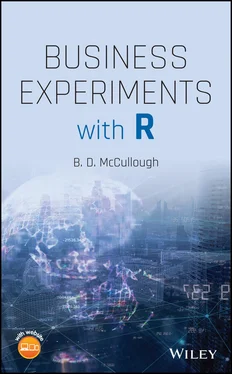1 ...7 8 9 11 12 13 ...18 1 1.2.1 Consider the five examples of lurking variables. We already described an experiment and a manipulated variable for the fire damage example. Come up with experiments and manipulated variables to expose the falsity of the observational conclusion for the bombing and drownings examples (we don't know the lurking variable for the other two).
2 1.2.2 For the following cases of observational data, articulate the precise nature of the sample selection.We wish to determine the effect of education on income by running a regression. (Think of the minimum wage.)Mutual funds that have been in business longer tend to have higher returns than newer mutual funds. We “know” this because we collected observational data on mutual funds, regressed return on number of years in business, and found that funds with more years had higher returns. (What happened to mutual funds with low returns?)
3 1.2.3 In the text, we asked, “If it is really the case that persons with higher credit limits are less likely to default, can we decrease the default rate simply by giving everybody a higher credit limit?” Definitely not! Why not? What is the lurking variable?
4 Using the data set credit.csv , create the variable “percentage default by age” () and plot it against age (). The relationship between and is definitely nonlinear. Describe the nonlinearity and a reason for it.
5 We know that regression results are biased when data have been selected due to a condition on the dependent variable, e.g. . What happens when the data are selected due to a condition on ? Subset the data for those values and run the regression. Is the slope estimate biased? What about the intercept? What can you conclude?
1.3 Case: Salk Polio Vaccine Trials
By the 1950s, polio had killed hundreds of thousands worldwide and infected tens of thousands per year in the United States. Many victims who did not die were condemned to spend the rest of their lives in “iron lungs” since they were unable to breathe on their own. To say nothing of the misery wrought by the disease, the effect on the community was devastating: parents kept their children indoors all summer, playgrounds were vacant, and one sick student in a class was reason for many healthy students to stay home from school. Jonas Salk developed a vaccine in 1952, and in 1954 two separate field trials were conducted, involving nearly 2 million children and 300 000 volunteers in the United States, Canada, and Finland. These constituted the largest clinical trials in history.
The first trial monitored nearly a million first, second, and third graders. The second graders were given permission slips for their parents to sign, and those children who got parental consent were vaccinated by injection. These children were compared with the non‐vaccinated first and third graders. The observant reader will have noted already that the sample is not random, and generalizing the results to the population would be problematic. Summaries are presented in Table 1.3. It appears that the vaccine worked; children who got vaccinated had a lower infection rate than children who did not get vaccinated.
Table 1.3 Results of first Salk vaccine field trial.
| Group |
Size |
Rate per 100 000 |
| Grade 2 vaccinated |
225 000 |
25 |
| Grades 1 and 3 |
725 000 |
54 |
| Grade 2 no consent |
125 000 |
44 |
Notice, however, that the number of second graders who did not receive permission markedly was nearly half the number who did get permission. If families who gave consent were similar to families who did not give consent, then we can assume that the difference in polio rates between the grade 2 vaccinated students and the grades 1 and 3 unvaccinated students is a good estimate of the overall effect of the vaccine at reducing polio. But are the families similar? Further analysis of the trial data showed that, on average, families who gave consent had higher incomes than families who did not give consent. What else might we deduce from this income difference, with respect to educational differences? Can we infer something about how often the children visited the family doctor and other such variables that are correlated with income and might affect the children's susceptibility to polio? How might this affect the results of the trial?
A more subtle problem arises because everybody involved in the experiment, including the physicians who monitored the children for polio, knew who had been vaccinated and who had not. Specifically, the experiment was not double‐blinded . In a blinded experiment (or single‐blind experiment), only the experimenter knows whether the subject gets the treatment or the placebo; the subject does not know. In a double‐blind experiment, neither the experimenter nor the subject knows whether the treatment or the placebo is administered. The reason that lack of blinding is a problem in this situation is that polio, when it is mild and not severe, can seem like a flu or other diseases. Physicians (who generally believe in the power of vaccines), when diagnosing a child with flu‐like symptoms, may be subconsciously biased to diagnose polio more often in the unvaccinated children than in the vaccinated children.
A formal review of this trial published in the leading statistical journal characterized the design as “stupid and futile” and the results of the trial as “worthless” (Brownlee, 1955).
To remedy these deficiencies in the first trial, a second trial focused only on children whose parents gave consent for vaccination. These children were randomly assigned to treatment and control groups, both of whom received an injection. The former received the vaccine, and the latter received a placebo saline injection. The observant reader will have noted already that there is no longer a sample selection problem. The results are presented in Table 1.4.
Table 1.4 Results of second Salk vaccine field trial.
| Group |
Size |
Rate per 100 000 |
| Treatment |
200 000 |
28 |
| Control |
200 000 |
71 |
| No consent |
350 000 |
46 |
Comparing Tables 1.3and 1.4is instructive. Note that the incidence for vaccinated children is roughly the same, 25 vs. 28, as is the incidence for children who did not get consent, 44 vs. 46. The incidence for the “control” groups has changed markedly, and it did not go down, but it went up! Apparently the children of parents who give permission are more susceptible to polio than the children of parents who do not give permission. Thus, the first experiment was biased against the vaccine: the treatment group that got the vaccine was more susceptible to polio, while the control group that did not get the vaccine was less susceptible to polio. No one involved in the trial foresaw this possibility, though an analyst trained in the design of experiments would have been able to guard against the possibility and eliminate it, even if she couldn't foresee it! How? By randomization ! We will have much more to say about randomization in subsequent chapters.
The variable “parents' propensity to give consent” is a lurking variable that is correlated with the outcome (the child getting the disease). Several mechanisms have been suggested for this correlation. For example, less educated persons are less likely to give consent, less educated persons are likely to have less income, persons with less income are less likely to live in sterile environments, and children who live in less sterile environments are more likely to have robust immune systems that offer more protection against polio.
Читать дальше












